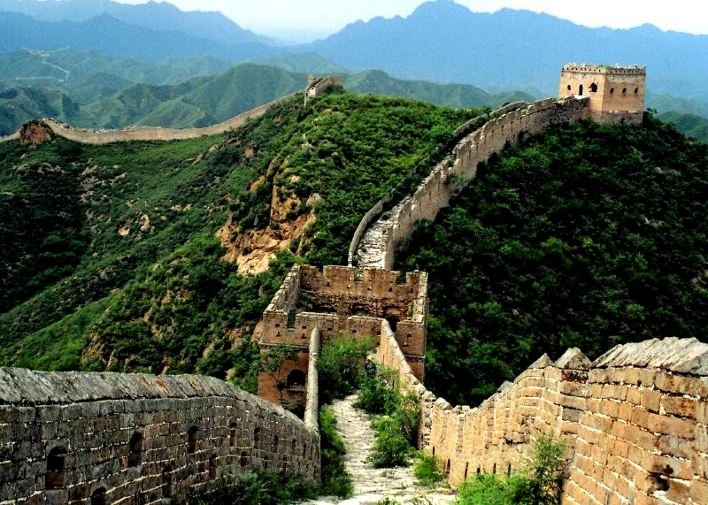
I’ve always been fascinated by the Great Wall of China (长城, Chang Cheng in Mandarin). The first time I had enough time and money to afford an intercontinental travel I took a flight from Paris to Beijing and I went straight away to see the Great Wall section of Mutianyu.
This was in February 2008 and since then I’ve visited the Great Wall other four times, once per year.
Great Wall of China – Index
- Where to visit the Great Wall of China?
- The head of the Great Wall: Badaling, Juyongguan, Mutianyu, Simatai, Jinshanling, Gubeikou, Jankou, Huanghuacheng and Huangyaguan
- Where the Great Wall meets the sea: Shanhaiguan
- The back of the dragon: Zhenbeitai and Yanmenguan
- The tail of the dragon: Jiayuguan and Yumenguan
- If you want to know more
Where to visit the Great Wall of China?
The Great Wall has often been compared to a giant dragon that stretches for about 8,850 km. The dragon has its head in Beijing and its tail in the desert of Gansu Province, along the silk road.
Even if it’s possible to visit many sections of the Great Wall, each one with its own characteristics, most of the people end up at Badaling, Mutianyu or Juyongguan.
In my opinion this happens because it’s not always clear which are the differences between the sections. Also, few travel agencies go beyond Badaling and Mutianyu.
This article contains a short review of fourteen sections of the Great Wall. The idea is to help you establishing which section fit better your requirements.
For each section of the wall I limit the information to the following facts: where the section is, how to reach it, how much it costs to enter the site and which are the main characteristics of the section (crowded or quiet, original or renovated, easy to climb or dangerous and so on).
This article obviously doesn’t cover the details you may need to reach a particular spot, especially if you are heading to the less popular sections of the wall. If you have any doubt you can ask me through the comment form below (but keep in mind that I didn’t visit all the sections I list).
A last thing before we start: many of the sections that we’ll review are close to Beijing. Click here in order to find a hotel (or an hostel) that suits your needs (beside reviewing the best hotels of Beijing, we also review some hotels near the Great Wall).
The head of the Great Wall: Beijing and its neighborhood
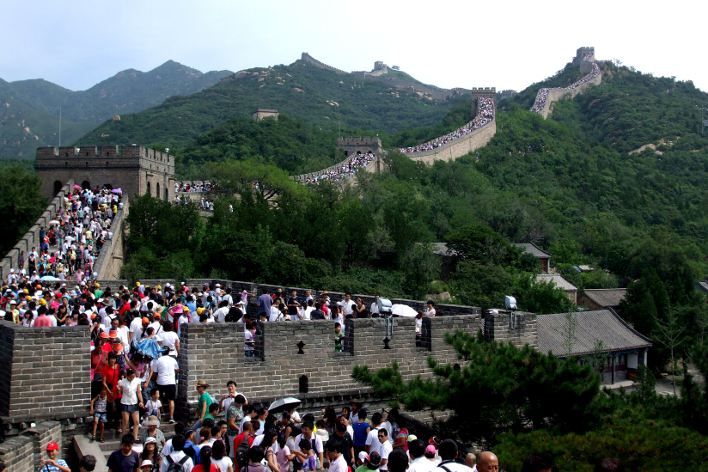 Badaling Great Wall on Summer. A bit crowded, isn’t it?
Badaling Great Wall on Summer. A bit crowded, isn’t it?
Badaling Great Wall
The Badaling (八达岭) Great Wall section is situated 80 km northwest Beijing. This is the best preserved and most visited section of the Great Wall of China. Especially in summer it gets extremely crowded and it has been heavily renovated. I’ve been there and I recommend to avoid it if you wish to see the “real” Great Wall. However if your goal is to see a wall of thousands and thousands of Chinese tourists, this is the way to go!
How to reach Badaling: Arrive to the Beijing’s subway station of Jishuitan (line 2), walk north till the Deshengmen bus station and take the bus number 919 till Badaling. You can also reach Badaling by train from Beijing North Railway Station. You find the details at Seat61.com
Admission Fee: 40 Chinese Yuan (November to March) 45 Chinese Yuan (April to October).
Detailed Review: BadalingGreatWall.com
Juyongguan Great Wall
The Juyongguan (居庸关) Great Wall section is a mountain pass located 50 km from Beijing. This is another very crowded section and I would avoid it.
How to reach Juyongguan: Arrive to the Beijing’s subway station of Jishuitan (line 2), walk north till the Deshengmen bus station and take the bus number 919 to Nankou. Get off at Nankou Dongjie station and take the bus number 68 till Juyongguan.
Admission Fee: 45 Yuan (April to October); 40 Yuan (November to March).
Detailed Review: TravelChinaGuide.com
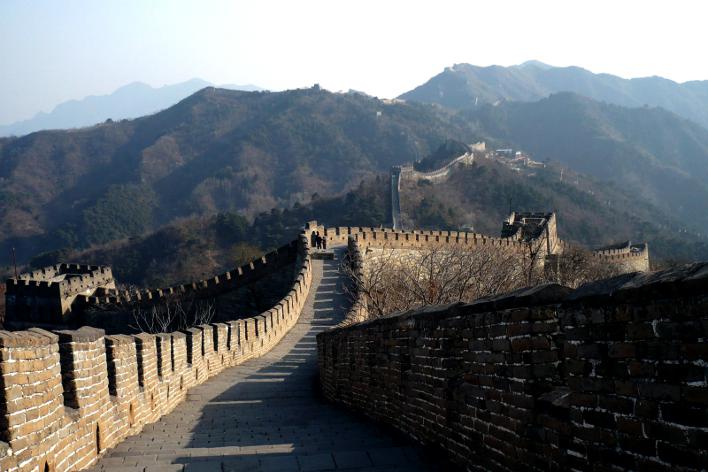 Mutianyu Great Wall on Winter.
Mutianyu Great Wall on Winter.
Mutianyu Great Wall
The Mutianyu (慕田峪) Great Wall section is located 70 km northeast of Beijing and is connected with Jiankou to the west. Although you can reach the wall using the stairs, this section is equipped with a lift. Also, you can ride down through a toboggan.
While Mutianyu may be very crowded on Summer, I’ve been there on February and I was alone. Now before to try that notice that the mountains that surround Beijing may be quite cold during the winter (even – 20 Celsius degree and the Siberian wind that will freeze your ass).
Mutianyu offers great landscape and represents a good trade-off for people that don’t want to travel too far from Beijing but at the same time would like to visit a section a bit more wild than Badaling or Juyongguan, especially in winter.
How to reach Mutianyu: The bus number 867 departs from the Dongzhimen bus station and arrives directly to Mutianyu between March 15 and November 15. In the winter you can take the buses number 936 or 916 till Huairou, which is 17 km away from Mutianyu. Then you can take a taxi till the wall (around 20 Yuan if you bargain hard).
Admission Fee (simple entrance): 45 Yuan (or 25 Yuan for kids under 12 years old).
Admission Fee (cable car, one way): 80 Yuan (or 45 Yuan kids under 12 years old).
Admission Fee (cable car, round trip): 100 Yuan (or 50 Yuan for kids under 12 years old).
Admission Fee (ascent by lift and descent by toboggan): 100 Yuan (or 60 Yuan for kids under 12 years old).
Admission Fee (descent by toboggan): 80 Yuan (or 60 Yuan for kids under 12 years old).
Detailed Review: Saporedicina.com
Simatai Great Wall
The Simatai (司马台) Great Wall section is located 120 km northeast of Beijing. Simatai it’s connected in the west to the Jinshanling and the Gubeikou Great Wall sections. It offers the possibility of a long hiking (many people choose to sleep up the wall as it takes quite a long time to complete it).
How to reach Simatai: In Beijing take the bus number 980 to Miyun from the Dongzhimen bus station. Once in Miyun, you need to take a private cab.
Admission Fee: 40 Yuan.
Detailed Review: TravelChinaGuide.com
Jinshanling Great Wall
The Jinshanling (金山岭) Great Wall section is located 125 km northeast of Beijing and is connected with the Simatai section to the east. Now you can also reach the highest point along the wall through a cable car.
How to reach Jinshanling: Take the bus number 980 from Beijing Dongzhimen bus station to Jinshanling. If you don’t find the direct bus (I think it only runs during the Summer), take the bus number 980 (yes, the number is the same) to Miyun and then a private cab till Jinshanling.
Admission Fee: 55 Chinese Yuan (16 November to 15 March) 65 Chinese Yuan (16 March to 15 November).
Cable Fee: 40 Yuan.
Detailed Review: TravelChinaGuide.com
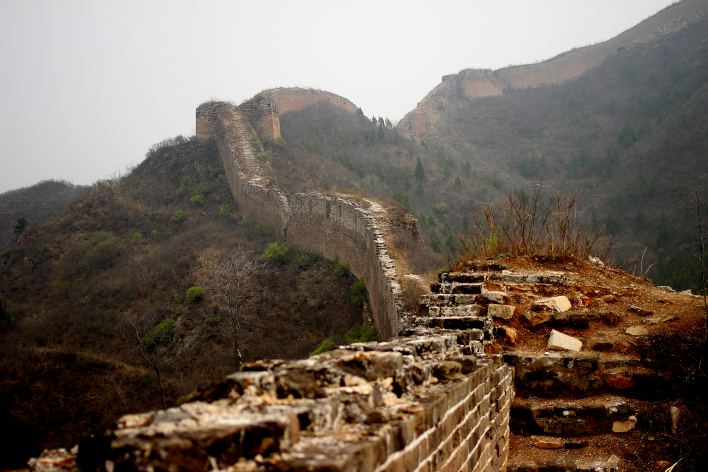 Gubeikou Great Wall on Spring.
Gubeikou Great Wall on Spring.
Gubeikou Great Wall
Gubeikou (古北口) is an ancient village 120 km North of Beijing from which depart two sections of the Great Wall: Wohushan (卧虎山) and Panlongshan (蟠龙山).
These sections of the Great Wall haven’t been renovated and so far Panlongshan is my favorite spot where hiking the Great Wall. Bryan Feldman, the author of the book Walk the Great Wall and founder of the Great Wall Forum, claims that Wohushan is even better and I believe him even if I didn’t have the time to hike it yet.
How to reach Gubeikou: Take the bus number 980 from Beijing Dongzhimen bus station to Miyun. Once in Miyun, either you take a private cab (you can bargain till 120 Yuan) or cross the road and walk one hundred meters till the stop of the bus 密25, which will bring you to Gubeikou in less than two hours (and at the cost of 7 Yuan).
Admission Fee: Even if the China Travel Guide claims that there is a fee of 25 Yuan, when I went there it was free.
Detailed Review (Panlongshan section): Saporedicina.com
Detailed Review (Wohushan): TravelChinaGuide.com
Jiankou Great Wall
The Jiankou (箭扣) Great Wall section is located close to the Mutianyu section. Jiankou literally means “Arrow Nock” and, according to many reviews, offers the most spectacular landscapes and opportunities for photographers.
How to reach Jiankou: Take the bus number 916 from Beijing Dongzhimen bus station and get off at Huairou Fangshan. Over there you will find the bus to Jiankou.
Admission Fee: None, however sometimes the local villagers may ask you to pay 10 or 15 Yuan.
Detailed Review: Saporedicina.com
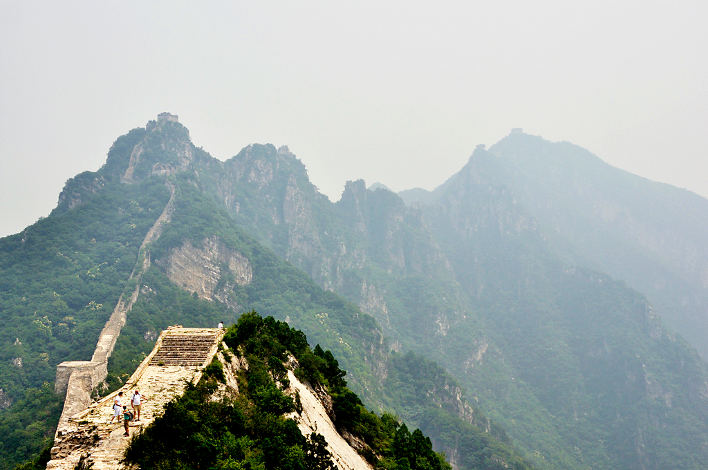 Jiankou Great Wall.
Jiankou Great Wall.
Huanghuacheng Great Wall
The Huanghuacheng (黄花城) Great Wall section is located 60 km from Beijing and is connected with the Mutianyu Great Wall to the east. The park hosting the Huanghuacheng section, the latest to become popular among hikers, also hosts a beautiful water reservoir.
How to reach Huanghuacheng: Take the bus number 980 from Beijing Dongzhimen bus station and get off at Huairou Dishui. Then take the bus till Shuichangcheng.
Admission Fee: 45 Yuan.
Detailed Review: Saporedicina.com
Huangyaguan Great Wall
The Huangyaguan (黄崖关) Great Wall section is located 120 km north of Tianjin (click here to read the review of the best hotels in Tianjin). Since the wall is built in a very sloppy mountain, in some points it looks like the wall is going straight up (or down).
How to reach Huangyaguan: From Beijing: Take a bus from Sihui Bus Station to Jixian County. When arrive in Jixian County, take a taxi. From Tianjin: Take a bus from Hebei Bus Station to Jixian County. When arrive in Jixian County, take a taxi. It takes one hour to reach the Great Wall.
Admission Fee: 50 Yuan.
Detailed Review: TravelChinaGuide.com
Where the Great Wall meets the sea
Shanhaiguan Great Wall
The Shanhaiguan (山海关) Great Wall section is the eastern limit of the Great Wall and is famous because it’s where the Great Wall meets the sea, in Hebei Province.
How to reach Shanhaiguan: Shanhaiguan has a train station. There are many direct trains from Beijing. Depending on the train the ride can take from two to six hours. Keep in mind the fastest trains are the class D and choose your train wisely! Here you find the scheduling.
Admission Fee: 15 Yuan (November to April); 40 Yuan (May to October).
Detailed Review: WikiTravel.org
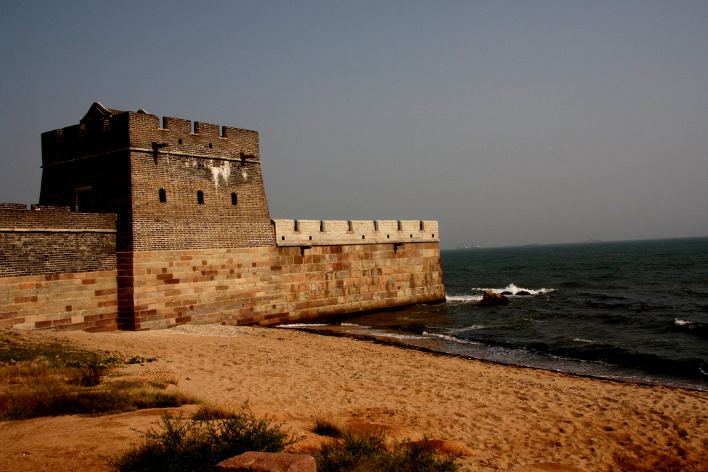 Shanhaiguan Great Wall.
Shanhaiguan Great Wall.
The back of the dragon
Zhenbeitai Great Wall
The Zhenbeitai (镇北台) Great Wall section is located on Mount Hongshan, five km north of Yulin City in Shaanxi Province. This is the central part of the Great Wall. The Zhenbeitai tower is one of the largest fortresses along the Great Wall.
How to reach Zhenbeitai: Either you take the bus number 3 from Guangji Mansion in Yulin or you take a taxi.
Admission Fee: 20 Yuan.
Detailed Review: ChinaTour360.com
Yanmenguan Great Wall
The Yanmenguan (雁门关) Great Wall section is situated on Yanmen Mountain, in Shanxi Province. Since the east and west side of the mountain face each other, the mountain looks like a huge door. The Yanmenguan Pass consists of three towers and it was one of the most important passes of the Great Wall.
How to reach Yanmenguan: By Bus: take a bus from Daixian County to Datong and get off at Yanmengua. You will still have to walk about 2 km to reach the Great Wall. You can also take a cab (about 100 Yuan from Daixian County). Here you find the review of the best hotels in Datong, in the case you decide to stay there for one or two nights.
Admission Fee: 90 Yuan.
Detailed Review: ChinaTravelGuide.com
The tail of the dragon: Gansu province
Jiayuguan Great Wall
The Jiayuguan (嘉峪关) Great Wall section is located six km from Jiayuguan City, in Gansu Province. This section is literally in the middle of the desert and has served as a gateway of the Silk Road for centuries. Jiayuguan represents the western end of the Ming Dynasty Great Wall (600 years old).
How to reach Jiayuguan: Take a taxi from Jiayuguan city.
Admission Fee: 102 Yuan (November to April); 122 Yuan (May to October).
Detailed Review: WikiTravel.org
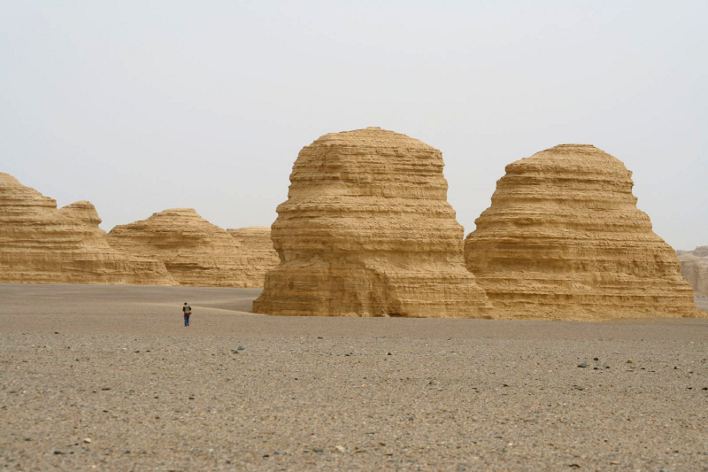 Dunhuang Yardang National Park.
Dunhuang Yardang National Park.
Yumenguan Great Wall
The Yumenguan Great Wall section is located about 90 km northwest of the city of Dunhuang, in Gansu Province (click here to read the review of the best hotels in Dunhuang). This section of the Great Wall was built during the Han Dynasty (namely it’s 2,000 years old and heavily deteriorated) and represents the Western edge of the Great Wall.
How to reach Yumenguan: Take a taxi from Dunhuang.
Admission Fee: 40 Yuan.
Detailed Review: TravelChinaGuide.com
If you want to know more
Walk the Great Wall is a massive book (524 pages illustrated with over 240 full-color photos) written by Bryan Feldman, who hiked the Great Wall everywhere it was possible and more.
The Great Wall: from Beginning to End is the book of William Lindesay and Michael Yamashita, an award-winning National Geographic photographer who spent a year shooting the Wall.
The Great Wall Forum is a very detailed forum dedicated to the Great Wall and managed by Bryan Feldman.
Photo Credits: ![]() Great Wall of China by DragonWoman
Great Wall of China by DragonWoman
![]() Jiankou Great Wall by Patrick He
Jiankou Great Wall by Patrick He
![]() Shan Hai Guan 101 by 若昔难得
Shan Hai Guan 101 by 若昔难得




Furio
Thank you for putting this website together. I’ve referred to it constantly the last few weeks.
We have settled on Huanghuacheng section given distance from Beijing and being non hikers.
Have you any recommendations for getting there for sunrise?
Cheers
Tom
Hello Tom,
no, I have no particular recommendations because I went there by car, with friends, thus I dont remember the details!
Thank you for recommending our website : )
Many thanks for this article. I’m still not sure where to go, more where not to, since I have no choice in timing. I will be in Beijing in the first half of July, but I can avoid weekends. I’m a fairly but not overly fit 67 year old, and worried about climbing up steep slopes or too many steps to reach the top of the wall in the July heat. Cablecars do have their attraction for me.
Which part of the wall reachable in a day trip from Beijing (I’ll have a Chinese friend with me), least crowded, most scenic do you recommend? I’m aware that I may have to compromise somehow. Thank you for your advice!
Hello Christiane,
I think Mutianyu offers the perfect trade off for you!
Cheers
I visited the Mutianyu section during Golden Week (!) and even then, thanks to an early start (6 a.m. or so), we had the wall to ourselves for the first 1 or 2 hours (which is enough to walk in either direction from the entry point and back). We used a transport organised by our guesthouse which was cheap and convenient. Next time in China I will choose a section more off the beaten track but for a first glimpse, Mutianyu was perfect! It’s hard not to be impressed by this massive structure …
Thank you for sharing your experience
This is helpful for you to get to Mutianyu Great Wall. It is easy and only take 20RMB for the ride.
beijingwalking.com/blog/mutianyu-bus.html
This was amazing info for someone really looking for concrete info to plan a short trip! Thank you thank you thank you!
You are welcome : )
I have visited Huangya Pass, near Tianjin. It was great experience and not so crowded. From what I hear about Beijing section, I think I was lucky NOT to go there, hehe.
: )
Excellent article.
: )
Hi! I just want to give you a huge thumbs up for the great information you have right here on this
post. I am coming back to your website for more soon.
Thanks for the credit for the photo :). However, the last photo is certainly not of the Yumenguan Great Wall but the Dunhuang Yardang National Park, some 40km northwest of the last visible stretch of the Great Wall.
Best wishes, Mark
Hey Mark,
thank you for the visit and the correction : )
Furio
Haha!
Honestly Furio I think this post of yours is supremely useful for those choosing to visit the Great Wall and not wanting the usual tourist experience.
In my honest opinion the worst thing anyone can do (unless they are very old) is to choose Badeling to visit for the first time. My first time I visited a section where there were only ten of us. I can’t for the life of me tell you where it was though… but it was a great experience.
I’m glad I hadn’t opted for Badeling.
Thank you : )
I wrote this post exactly for this reason. The first time I came to China I visited Mutianyu, which was empty as it was February and there were -20 C degree.
Then I visited Huanghuacheng (nobody was there) and Badaling (and there were more people than in Time Square for New Year Eve).
Finally I discovered Gubeikou, the heaven haha
What really disturbed me is that I was choosing by chance, without a clear idea of the options I had.
Then I start to do some researches and found that there were so many sections I could visits…
This is a great post Furio! Well done.
If only the Chinese board of tourism department could come up with something as useful it would certainly save many people from the experience of going to the ‘evil’ Badaling section.
I’ve been to Badaling on July and it’s kind of interesting to see how many people can fit up a wall. I think the photo speaks for itself : )